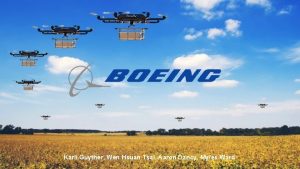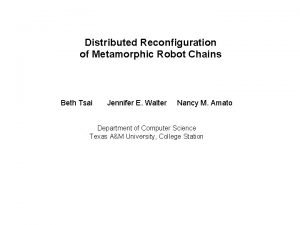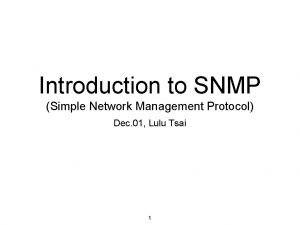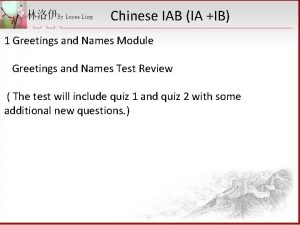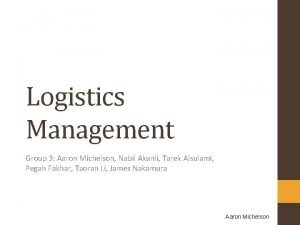Karli Guyther Wen Hsuan Tsai Aaron Dancy Myles

















































- Slides: 49

Karli Guyther, Wen Hsuan Tsai, Aaron Dancy, Myles Ward

Overview and Agenda Selection Considerations Entry Mode Option 1: Partnership Evaluation Entry Mode Option 2: Acquisition Evaluation Recommended Entry Mode Selection 2

Selection Considerations Create Value - Synergy, Growth, Increase Market Power, Acquire Unique Capabilities and Resources Product Differentiation - Ability to Create a New Product for Niche Purpose Technology Transfer - IP Costs, Competitive Advantage Financial and Legal Barriers - Overcoming Adverse Government Policy, Financing R&D Corporate Culture - Restructuring, Overall Vision Compatibility, Employee Practices 3

Entry Into the Courier & Delivery Services Industry Option 1: Partnership with Fed. Ex Option 2: Acquisition of Workhorse 4

Entry Mode Option 1: Partnership Evaluation Create Value? Product Differentiation? Technology Transfer? Financial & Legal Barriers? Corporate Culture? 5

+ Insitu (Wholly Owned Subsidiary of The Boeing Company) ● Acquired by Boeing in 2008 ● Provides UAV aircraft and Control Systems in defense, government and commercial industry ● Already has portable and reliable commercial drones but doesn’t have delivery drones yet Strategy ● Invest heavily in Research & Development to build a new commercial drone for delivery purposes in the logistics industry ● Start by partnering exclusively with Fed. Ex for delivering packages in test cities ○ Drones will deliver packages to homes in urban areas ■ Deliveries will be picked up from Fed. Ex distribution centers ● Boeing will strictly manufacture the drone technologies. Fed. Ex will handle operations and logistics of deliveries 6

Entry Mode Option 1: Partnership Evaluation PROS CONS International market share Insitu hasn’t built commercial drone for parcel delivery Direct entry into logistics industry Huge financial investment in R&D Operate aircraft in diverse environments/conditions Long time before profitability Data security issue 7

Entry Mode Option 2: Acquisition Evaluation Create Value? Product Differentiation? Technology Transfer? Financial & Legal Barriers? Corporate Culture? 8

+ Synergies of Acquisition: + 9

+ Synergies of Acquisition: UH-6 Little Bird (UAV) + 10

+ Synergies of Acquisition: 11

Entry Mode Option 2: Acquisition Evaluation PROS CONS Already developed commercial drone Not yet a profitable company Boeing offers economies & scalability Company’s current strengths lie in electric vehicle production Existing Partnerships with UPS, Fed. Ex, USPS Workhorse has a differentiated product offering that isn’t focused solely on drones 12

Recommendation: Acquire Workhorse 13

Implementation Strategy Step 1 Step 2 ACQUIRE: TRANSITION: Make Offer to Purchase Workhorse and have them accept the offer Perform acquisition transaction and conduct synthesis of administration and assets over 100 day period. Boeing is proposing paying $3. 50 - $3. 75 per share of Workhorse to completely acquire the firm and their assets During the transition phase, Boeing will bring key stakeholders together to determine a strategy plan for expanding the product lines or additional actions to be taken Step 3 TURBOCHARGE GROWTH: Upon completion of the transition phase, Boeing will begin to implement the growth strategy plan for the Horsefly drone delivery system as well as other legacy-Workhorse products 14

Preliminary Corporate Restructuring Divest Truck Unit Combine Aviation Units + = Drone Division 15

Valuation Analysis - Comparable Company Baseline Tesla Comparison: Tesla is similar to Workhorse overall in their innovative product lineup of electric based vehicles, technological breakthroughs, and profitability in early stages following the same trend lines. Tesla’s sales growth rates and cost of sales/sales figures were used to project future FCFs for Workhorse 16

Financial Acquisition Analysis The financial analysis began by projecting FCFs for Workhorse as seen in the table below: Growth Projection Aggressive (100%) Moderate (50%) Mild (30%) Weak (10%) 2018 2019 $2, 624, 961 $480, 723 $2, 032, 959 $(82, 235) $1, 796, 159 $(266, 165) $1, 559, 358 $(426, 520) FCF 2020 $19, 885, 845 $6, 481, 631 $3, 302, 504 $1, 114, 228 2021 $39, 737, 124 $11, 209, 155 $5, 607, 860 $2, 192, 865 2022 $41, 902, 827 $10, 744, 692 $5, 229, 264 $2, 064, 277 We decided to use the ‘Moderate’ growth rate (50% Tesla) going forward in the valuation calculations as this best matched the risk profile and expected sales in the future. A time period of five years was chosen as the explicit forecast due to simplicity and market uncertainty. 17

Financial Acquisition Analysis Enterprise DCF Valuation Cont. Value (t=5) $193, 557, 590 Discounted CV $121, 725, 400 Sum of Disc. FCFs $21, 832, 799 Total Estimated Value $143, 558, 199 Shares Outstanding 41, 130, 000 Estimated Value/Share $3. 49 Current Price (11/10/17) $2. 72 Boeing Proposal: Cash purchase of all shares outstanding at a price of $3. 50/share - $3. 75/share 18

Implementation Timeline 4 Q 2017 - 1 Q 2018 (6 mos) Acquisition Negotiation This time period will consist of negotiating and closing on the actual acquisition deal Subject to change based on FTC approval and negotiation timeline 2 Q 2018 (100 Days) 3 Q 2018 - 4 Q 2019 (18 mos) 2020 and beyond First 100 Days Transition Begin Expansion Strategy Continue to Grow in Courier and Delivery Industry This time period will consist of the transition of Workhorse assets, employees, and business to Boeing The launch plan will be conducted during this period and lobbying Congress for drones will begin Once fully implemented, launch strategy will commence to scale up manufacturing and to provide the resources needed for R&D Any divestitures or restructuring will occur begin at this time Begin manufacturing and servicing drone products to the C&D industry, beginning with UPS and the USPS Focus on growth of market share as a first-mover 19

THANK YOU 20

Appendix 21

Current Landscape of Unmanned Aerial Vehicle Manufacturing Industry 22

Drones in Logistics Industry PESTEL Political: Growing concern with drones and privacy. Political pressure to expand drone use for commercial purposes. Increased concern with safety and payload hazards as well as concerns for potential for drones to be used for terrorist attacks. Economical: Economies of scale and improvements in drone technology have brought the cost of drone technology down substantially making it more affordable for consumers and businesses alike. As economies grow around the world, more opportunities for drones are becoming possible due to economic growth and lower price. Historically low interest rates make financing drone purchases feasible for companies looking to enter the space and take advantage of capitalization. Sociocultural: Increased acceptance of technology in general, as well as drones themselves bodes well for the future of the industry. The concept of a drones delivering parcels/items is not farfetched or rebuffed by consumers. Drone technology’s environmental benefits also help increase the acceptance of this new technology. Technological: Advances in drone flight controls, electrical batteries/charging, long distance flight controls, and navigation technology have all been factors of growth for this industry. These improvements have also made drone technology affordable and easier to control/use. Autonomous aerial flight technology has also led to the increase in applications for drones and the flexibility of drones to be used for different tasks. Environmental: Increased public concern over emissions and climate change is positively impacting the drone industry as it enables logistics companies the ability to increase packaged deliveries while reducing the amount of emissions from trucks, especially in rural routes where driving long distances between delivery locations can be long. Legal: Current legal restrictions and regulations are a roadblock to further application of drone technology, but most recently, the Trump Administration passed an executive order enabling the expansion of commercial use for drones which bodes well 23

Legal Barriers for Commercial Drones in the U. S. ● ● ● Numerous crashes, "near misses" and other incidents have raised concerns over the proliferation of drone use ○ Ex. At least two drones have landed on the White House lawn As a reaction to these issues, on 2012, Congress enacted the FAA Modernization and Reform Act (FMRA) in order to give the FAA control over the regulation of unmanned aircraft. ○ The United States has banned UAV commercial use without express authorization by the Federal Aviation Administration (FAA) through its exemption process; however, the FAA has dramatically accelerated the pace of issuing exemptions. ■ Lobbying Efforts have increased dramatically in support of commercial drone usage ● A delivery of medicine to a rural Virginia clinic in in July 2015 was the first FAA-approved drone delivery. ● In December 2013, Amazon. com announced that it was developing Amazon Prime Air to deliver packages to customer in 30 minutes using drones. ● Google is developing a package delivery service that it aims to have in service in 2017. ■ New Trump Proposal ● Two weeks ago, President Trump signed a memorandum intended to broadly expand how drones are used in the United States using a new pilot program. ■ Current bills in Congress are moving toward easing restrictions while also focusing on privacy concerns ■ Federal Drone Advisory Panel was charged by the FAA in determining what role federal, state and local officials should play in regulating drones buzzing over communities at low altitudes. ● Met this past week to continue development of regulations Exemptions are being granted with increasing frequency, especially in the following industries: ○ Oil field and pipeline insepections, Filmmaking, Aerial Surveying, Construction Site Monitoring, Precision Agriculture, and Real Estate Photography 24

Supreme Court Outlook ● To date, the Supreme Court has not opined specifically on drone technology, but holdings from other cases provide some insight as to how the Court will address the constitutional issues involved. ○ Court precedent allows police to observe individuals and private property from the air to collect the evidence necessary to obtain a warrant. ■ In California v. Ciraolo, the Court held it was not an unlawful search for police to observe, from an altitude of 1, 000 feet, the backyard of an individual they suspected of growing marijuana. ■ Likewise, the Supreme Court did not find photographing industrial complexes with an aerial-mapping camera from navigable airspace to require a warrant in Dow Chemical Co. v. United States. ■ Years later, the Supreme Court gave the police even more latitude, finding that the use of helicopters for surveillance at a height of 400 feet did not require a warrant. ○ It’s easy to see how drones fit into this framework, and that the Court seems to be lowering the bar. 25

Drones in Logistics Industry Dominant Economic Characteristics Market Size and Growth Rate: ● Industry revenue is 3. 8 billion with -0. 5% annual growth. Over the next five years, the industry is estimated to increase at 3. 6% annual rate to reach 4. 5 billion ● In 2017, the industry revenue is expected to increase by 3. 8% Scope of Competitive Rivalry: ● There about 88 competitors in UAV industry ● There are no key players in the delivery drones industry yet, but strong competitors include Amazon Prime Air, Zipline, Matternet Product Innovation: Artificial intelligence are widely applied to drones to provide new service in different industry Drones are now designed to be lighter, capable of carrying, and sustain longer Economies of Scale: To reach efficient economies of scale, it requires enough global production, forward-thinking technological advancements, and substantial number of highly skilled workers Learning Curve Effect: Learning to adapt in different industry, ex: agricultural industry, and in different usage, ex: communications and public sector Improving on previous production methods 26

Drones in Logistics Industry Five Forces Threat of New Entrants: Medium Capital requirements are low(+): Drone industry is characterized a low level of capital intensity Restrictive government regulations exist(+): The industry not only has to comply with general business regulations and import/export regulations, but it also needs to follow FAA regulations that restrict the use of UAVs to recreational purposes. The minimum efficient scale to compete in the industry is high(-): To reach minimum efficient scale in this industry, companies need large warehouses, enough technology-savvy employees, ability to increase productivity to spread high fixed costs, and so on. It takes substantial efforts and money to reach the minimum efficient scale Threat of Substitutes: Medium Substitutes don’t have comparable features(-): Delivery drones’ main substitute are trucks. Although both drones and trucks provide delivery services, drones are more efficient and economic friendly Low switching costs between substitutes(+): For logistics providers, they can easily switch back to trucks if they are not satisfied with drones’ performance without paying extra costs Good substitutes are not readily available(-): There are some substitutes for drones, but drones are the only tool that can be used in the sky to deliver packages in a short distance. It can save costs and time Power of Suppliers: Strong ● Suppliers do not depend heavily on the industry for their revenues(+): Most companies buy components from third party suppliers that specialize in relevant aircraft parts, so it’s highly possible that drones only take small proportion of suppliers revenue ● Suppliers can threaten to forward-integrate into the industry(+): Suppliers have potential to forward-integrate into the industry because they already have the components and skills 27

Drones in Logistics Industry Five Forces Power of Buyers: Weak Buyers face relatively high switching costs(-): Some companies provide aftermarket sales service and rental drones for purchasers. Most equipment is pricey, rental services provide an easier way for logistic companies. Due to the need for rental services and aftermarket sales services, buyers’ bargaining power is relatively low Buyers cannot threaten to integrate backwardly(-): Starting a UAV company requires intensive capital and huge warehouses. It also requires sufficient operating costs to run the business smoothly Buyers can easily compare drones price and quality(+): With the development of technology, customers can easily compare prices and functions from different models Rivalry among Existing Competitors: Strong Exit barriers are high(+): In such a capital-intensive industry, companies invest heavily in its equipment and technology development. If the firm plans to exit the industry, it will lose a huge amount of capital No cost leading companies in the industry(+): None of the companies have low-cost advantage, so competitors are forced to compete with quality, brand recognition, innovation and integrity 28

Drones in Logistics Industry Drivers of Change Regulation ● This industry is highly regulated, and exports are subject to many restrictions that prevent significant export volume. Further, right now the domestic civil market is limited by regulations that restrict the use of UAVs to recreational purposes. However, these regulations are expected to decline in the coming year. Price of Inputs ● The price of inputs can determine profitability. The prices of things like semiconductors and other electronic inputs can vary significantly depending on new technological innovations, availability, etc. Technological Advancements ● New technologies are being created every single day that affect the ways drones can be applied in new markets. Artificial Intelligence, in particular, will be a key feature in the commercial delivery application of drones. Consumer Shopping Trends ● A key to demand for drones in the logistics industry is a steady increase in the need for delivery services worldwide. International e-commerce has been a huge driver in the increase in demand for courier services; therefore, it will also be a driver when designing drones specifically for commercial delivery of these types of products. 29

Drones in Logistics Industry Competitor Identification & Strategies Amazon Prime Air ● Strategy: Safely deliver package by drones in 30 minutes or less ● First private trial ○ Dec 7 2016 in Cambridge ● Drone feature. S ○ Carry package up to 5 pounds ○ Fly up to 500 feet ○ Sense avoid technology to avoid obstacle ○ Automatically scan landing area ● Test Prime Air delivery vehicles to discover how to deliver packages in a variety of operating environments Matternet ● Strategy: Integrated with Matternet Station to deliver packages by using M 2 Drone and Mercedes-Benz vans ● Target Industry ○ Healthcare, e-commerce and logistics organizations ● First trial ○ Sep 27, 2017 ● Drone features ○ Combined M 2 Drone + Matternet Station + Matternet Cloud ○ Carry payloads of up to 2 kilograms and 4 liters ○ Fly up to 20 kilometers ● First company in the world to receive authorization for full operations of drone logistics networks over densely populated areas in Switzerland ● Exclusive partner of Mercedes-Benz Vans for integrating its drone logistics system 30

Drones in Logistics Industry Competitor Identification & Strategies Zipline ● Strategy: deliver urgent medical supplies by drones, ex: blood, HIV medications, and emergency vaccine ● World’s only drone delivery system at national scale ● First services ○ Fall of 2016 in Rwanda ● Drone features - Zips ○ 25 pounds ○ Carry up to 1. 5 kilogram of blood ○ Delivery service radius is 75 Kilometers ○ Order supplies via mobile phone ○ All weather performance ○ Delivery 500 supplies per day 31

Weighted Competitor Strengths Analysis Workhorse Amazon Prime Air Matternet Zipline Key Success Factors Importance Weight Strength Rating Weighted Score Research and Development 0. 15 7 1. 05 8 1. 2 6 0. 9 Ability to Break Into New Sectors 0. 15 7 1. 05 Ability to Quickly Adapt to New Technologies 0. 2 8 1. 6 7 1. 4 8 1. 6 Well Developed Internal Processes 0. 3 6 1. 8 7 2. 1 6 1. 8 8 2. 4 Partnerships and Contracts 0. 2 8 1. 6 6 1. 2 7 1. 4 6 1. 2 Overall Weighted Competitive Strength Rating 1 7. 1 6. 95 6. 75 7. 15 Takeaway: Delivery drones industry is relatively new. It doesn’t have any leading company in the industry yet. For Workhorse, it has already partnered with UPS to enter directly into logistic industry, so it makes sense to have the highest Partnerships and Contacts factor score. For Amazon Prime Air, it has relatively high R&D because its parent company has spent substantial capitals on the creation of drones for Amazon. For Matternet, it recently launched Matternet Station, which is fully-automated battery and package exchange for Matternet customer networks. It adapted new technology to create new drone’s supported product. For Zipline, World’s only drone 32 delivery system at national scale, its drones can perform well under all weather-condition and deliver blood packages in a short amount of time, so it has the highest Internal Processes factor scores

Drones in Logistics Industry Key Success Factors ● ● ● Research and Development ○ Future revenue streams are contingent on heavy investments into new, innovative uses for drones as well as increased efficiencies. Ability to Break into New Sectors ○ Right now, the drone industry is heavily reliant on the government and defense markets. The future of this industry will depend on the ability to find applications outside of defense in new areas, such as logistics and delivery. Ability to Quickly Adapt to New Technologies ○ Technical innovation is the foundation of new product launches in this industry. Advances in areas such as artificial intelligence are quickly changing the way service is rendered in many industries, and companies must be able to implement these new technologies in order to find new applications for new and existing products. Well-developed Internal Processes ○ Goods inventory and cost management can help companies in this industry be more competitive. As the value of goods in this industry is typically very high, businesses aim to keep inventories low. Partnerships and Contracts ○ Because regulations are not very favorable to this industry yet, it is crucial for companies to score contracts with government contractors as well as partnerships with bigger companies with more lobbying power in order for progress to be made in the commercial drone sector. 33

Internal Analysis - Partnership 34

Why Not USPS? ? ● ● ● Net loss of $5. 6 billion, driven by mandated retiree health benefits expenses Controllable income of $610 million Continued double-digit growth in revenue and volume in the Shipping and Packages business Enactment of postal reform legislation remains urgently needed “To drive growth in revenue and better serve our customers, we continue to invest in the future of the Postal Service by leveraging technology, improving processes and adjusting our network, ” said Postmaster General and CEO Megan J. Brennan. “In 2016, we invested $1. 4 billion, an increase of $206 million over 2015, to fund some of our much-needed building improvements, vehicles, equipment and other capital projects. ” Financials: https: //about. usps. com/news/national-releases/2016/pr 16_092. htm 35

Fed. Ex Current Strategy Generic Strategy ● Broad Differentiation - Fed. Ex offers wide range of delivery and printing services to customers across the world, including Fed. Ex Express, Fed. Ex Ground, Fed. Ex Freight, and Fed. Ex Services. Its dimensional weight pricing strategy allows Fed. Ex charge fair value for the most valuable assets and maximize the space in trucks Individual Strategies ● Mergers and Acquisition ○ $4. 9 billion acquisition of TNT Express - one of the world’s biggest express providers enables Fed. Ex to expand its existing portfolio of international transportation solutions, especially in European road network ○ Acquire businesses in Latin America, Africa and the U. S. over the past years, ex: acquired GENCO in 2015 and Bongo International LLC in 2014 ● Grow internationally ○ TNT Express serves over 200 countries, which helps Fed. Ex grow its global network and strengthen supply chain capabilities ● Grow through technology and e-commerce ○ Investment in new aircrafts and vehicles enable Fed. Ex to reduce maintenance costs and carbon footprint, ex: buying compressed natural gas tractors and CNG fueling stations ○ Development of new technology makes return processes simpler, delivery services easier, and monitoring packages more convenient ○ Cross-border shopping is growing at a fast pace, and it is an avenue for new potential customers ● Grow through new services and alliances ○ Fed. Ex Office On. Campus program expands to serve healthcare campuses. The program provides printing and shipping services to students ○ Alliance with Walgreen will add approximately 8, 000 locations to Fed. Ex On. Site network ○ New Fed. Ex Cross Border services provide shoppers with an easier and faster way to conduct international e-commerce ● Retain annual rate increases ○ Streamline delivery process to decrease the time and required resources ○ Apply dimensional weight pricing for all Fed. Ex Ground packages allows Fed. Ex charge fair value for the most valuable assets and maximize the space in trucks 36

Fed. Ex Weighted Competitor Strengths Analysis Fed. Ex Key Success Factors UPS USPS Importance Weight Strength Rating Weighted Score Price . 15 6 0. 9 4 0. 6 Quality/Reputation . 15 7 1. 05 9 1. 35 4 0. 6 Logistics . 25 7 1. 75 8 2. 0 4 1 Domestic Territorial Coverage . 2 7 1. 4 8 1. 6 9 1. 8 Reliability . 1 8 0. 8 5 0. 5 Consistency . 15 7 1. 05 8 1. 2 4 0. 6 Overall Weighted Competitive Strength Rating 1 6. 95 7. 85 5. 1 Takeaway: UPS is the clear industry leader in the U. S. as well as abroad right now. Fed. Ex is closely behind them with slightly less market share and brand recognition. However, with strategic focus on logistics and partnerships that allow for continuous innovation, Fed. Ex will remain a leader. USPS falls behind in almost every category, except domestic territorial coverage - it reaches many rural areas that the other competitors do not. However, Fed. Ex has the opportunity to utilize drones as a channel for increased territorial coverage, which may allow it to take even more market share away from USPS. 37

Fed. Ex VRINO Valuable Rare Inimitable Global Presence X X Research and Development X Advanced Technological Capabilities X X X High Operating Efficiency & Improved Quality and Manufacturing X X X Acquisition Strategy X X X Non-substitutable Organized to Capture Value X Sustainable Competitive Advantage? No No No X X Yes No Fed. Ex has multiple competencies that have helped distinguish them as a leader in the global logistics industry; however, only one of these competencies has the potential to prove itself as a sustainable competitive advantage in this competitive industry - High Operating Efficiency & Improved Quality and Manufacturing. Although the other competencies in this chart are valuable to Fed. Ex and should be invested in, they are easily copied and do not provide the necessary capabilities needed to succeed in the logistics industry. Fed. Ex’s strength in Operating Efficiency helps drive efficiency as well as the bottom-line. This sustainable competitive strategy partnered with the other listed competencies make Fed. Ex a very viable candidate for entry into this industry through a strategic partnership. 38

Fed. Ex SWOTA Strengths ● ● The world’s largest air express network Consistently ranked among the most-desired companies Strong financial standing and growing revenues Focus on sustainable fuels and energy-saving technology Opportunities ● ● ● Development of technology in logistics industry, especially artificial intelligence Growing global e-commerce at double-digit rates Cooperative strategy with foreign countries Serve niche market or additional customer groups (Alternative) Expand the range of service (Alternative) Weaknesses ● ● Sustainable development of transportation High capital expenditures Threats ● ● ● Fluctuated fuel price Increased competitive pressure Risks related to international expansion Changes in currency exchange rate Data breach or another disruption to the technology infrastructure Takeaway: Fed. Ex’s strong financial standing and growing revenues make it one of the world’s largest logistics providers. It has been able to utilize its strengths in investing sustainable fuels and solar panel facilities. It also has been actively acquiring third-party logistics providers to expand into new territories, especially international markets. The growing global e-commerce makes the industry even more attractive. Although Fed. Ex has been running for almost 50 years and has overcome many learning curves, it still face high capital expenditures because of the necessarily intensive operating costs in this industry. Changes in currency rates, fluctuated fuels rates, data breach and so on 39 are threats that could potentially harm Fed. Ex’s profits.

Fed. Ex - Internal Development with Insitu ● Acquired by Boeing in 2008 ● Provides UAV aircraft and Control Systems in defense, government and commercial industry ● Already has portable and reliable commercial drones but doesn’t have delivery drones yet Strategy ● Invest heavily in Research & Development to build a new commercial drone for delivery purposes in the logistics industry ● Start by partnering exclusively with Fed. Ex for delivering packages in test cities ○ Drones will deliver packages to homes in urban areas ■ Deliveries will be picked up from Fed. Ex distribution centers ● Boeing will strictly manufacture the drone technologies. Fed. Ex will handle operations and logistics of deliveries 40

Fed. Ex Financial Analysis Financials Profitability 41

Fed. Ex Financial Analysis Liquidity/Financial Health Key Ratios -> Efficiency Ratios 42

Internal Analysis - Acquisition 43

Workhorse Current Strategy Generic Strategy ● Focused differentiation - Workhorse offers a very unique product to a narrow audience. Right now drones can only really be sold for defense and entertainment uses, but moving forward, this strategy become more broad in terms of its target audience as regulations become less stringent. Individual Strategies ● Partnerships ○ Workhorse currently supplies both UPS and Fed. Ex with delivery vans that are more fuel efficient ○ Workhouse has a current contract with UPS to deliver 200 more vehicles ○ Currently beta testing drone capabilities with UPS a means to innovate delivery to rural areas ○ In the process of trying to win a bid with the USPS who has pledged to spend $6. 3 million on updating and outfitting new delivery trucks ● Technology and Innovation ○ Continuing to innovate the W-15 pick up truck ○ Working on delivering Fed. Ex express with Hydrogen Fuel Cell Chassis ○ Beginning development on E-Gen van concept ● Scalability ○ With Workhorses current product portfolio, the goal is to continue to fill orders and improve process flow in order to begin to scale production ○ Have increased the run rate from. 7 vehicles per day in Q 1 to 3 vehicles per day at the end of Q 3 ○ Plan is to scale production over the next 24 to 36 months 44

Workhorse Weighted Competitor Strengths Analysis Work. Horse Key Success Factors Matternet DJI Importance Weight Strength Rating Weighted Score Price . 15 6 . 9 5 . 75 7 1. 05 Quality/Reputation . 15 7 1. 05 8 1. 2 Logistics . 20 7 1. 4 Reliability . 25 6 1. 5 Consistency . 25 7 1. 75 5 1. 25 7 1. 75 Overall Weighted Competitive Strength Rating 1 6. 6 5. 95 6. 9 Takeaway: Workhorse is a company that is currently focusing on scaling its commercial electric vehicle production, but is also creating synergy in the logistics industry. With its product offering, Workhorse is poised to continue to be the leader in building more fuel efficient means for the delivery and logistics offering. With the strategy of scaling, Workhorse is continuously focusing on its 45 reliability and consistency to insure that the service remains an industry leader.

Workhorse VRINO Valuable Rare Inimitable Non-substitutable Organized to Capture Value Sustainable Competitive Advantage? Research and Development X Advanced Technological Capabilities X X X Yes High Operating Efficiency & Improved Quality and Manufacturing X X X Yes Acquisition Strategy X X No No Takeaway: Based on the VRINO, it is easy to see that Workhorse relies heavily on its technological capabilities and operating efficiency. Currently Workhorse is keeping up with the demand of its products, but will need to scale quickly as the success of its truck and van offerings are widely realized. These two key focus areas for Workhorse work extremely well with Boeing due to Boeing’s expertise in operational efficiencies and innovative technology advances. The synergy between these 2 companies will be a mutualistic benefit as 46 they will continue to bring the products and service offerings of both companies to the demand of the industry.

Workhorse SWOTA Strengths ● ● Product differentiation Current partnership with UPS and USPS $3 million increase in revenue over the last quarter Market leader in U. S commercial electric vehicles Opportunities ● ● ● Currently working to bring operations to commercial scale production Logistics and delivery industry is experiencing a high level of change and are searching for ways to innovate Scale production and availability of products Weaknesses ● ● Current scalability Company is still not yet profitable Threats ● ● FAA regulations Similarly innovative competitors in the commercial logistics space Takeaway: Workhorse delivers a strong product offering that promotes quality in its services and ability to enhance the logistics and delivery industry. Workhorse is currently supplying fuel efficient trucks to 2 of the largest logistics companies in the world and currently developing a system that creates synergy in the industry by incorporating the use of drone technology. There is a huge opportunity for Workhorse to scale its production as they continue to fill more orders with the largest logistics and delivery companies. Workhorse is currently the market leader in supplying U. S. commercial electric vehicles and with a strategy to scale its operations, will continue to command this market space. 47

Workhorse Financial Analysis Financials Balance Sheet Bottom Line 48

Workhorse Financial Analysis Key Ratios 49
 Wen-hsuan tsai
Wen-hsuan tsai Chen-hsuan lin
Chen-hsuan lin Discrete mathematics
Discrete mathematics Karli burns
Karli burns Puja myles
Puja myles Myles king
Myles king Myles ruck
Myles ruck Puja myles
Puja myles Puja myles
Puja myles Puja myles
Puja myles Sandy myles
Sandy myles Myles boylan nsf
Myles boylan nsf Beth tsai
Beth tsai Charlene tsai
Charlene tsai Lulu tsai md
Lulu tsai md Eddie tsai
Eddie tsai National professor
National professor Fast radio burst
Fast radio burst Effective communication in the digital age
Effective communication in the digital age Jerry tsai
Jerry tsai Shannon tsai
Shannon tsai Robin tsai
Robin tsai Splunk ftr
Splunk ftr Chi wen chen
Chi wen chen Tue thu
Tue thu Jugendarbeitsschutzgesetze
Jugendarbeitsschutzgesetze Qing wen nin gui xing
Qing wen nin gui xing Ni hao wo jiao shenme mingzi
Ni hao wo jiao shenme mingzi Wen chi chen
Wen chi chen So wen milano
So wen milano Chun tzu confucianism
Chun tzu confucianism Edward wen
Edward wen Planet ring ping
Planet ring ping So wen
So wen Wen rtc
Wen rtc Mon to thu
Mon to thu Cs1101
Cs1101 Journey aaron becker powerpoint
Journey aaron becker powerpoint Aaron frankel
Aaron frankel Scalable web architectures
Scalable web architectures Aaron michelson
Aaron michelson Aaron delp
Aaron delp Aaron apel
Aaron apel Aaron mulder
Aaron mulder Automatische gedanken depression beispiele
Automatische gedanken depression beispiele Aaron tan nus
Aaron tan nus Aaron choate colorado springs
Aaron choate colorado springs Aaron beck theory
Aaron beck theory Aaron barzilai
Aaron barzilai Aaron yeshayahu
Aaron yeshayahu
